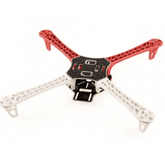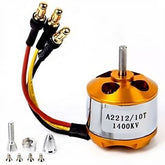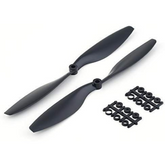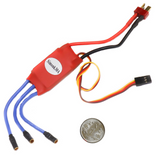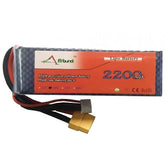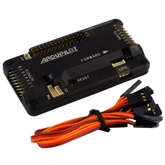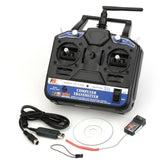How drone works?
Summary
Explore the fascinating world of drones in our latest blog! Discover the intricate inner workings of these high-flying marvels, from their sophisticated structures to cutting-edge communication systems. Delve into the realm of imaging and sensors that empower drones to capture breathtaking vistas. Uncover the brain behind the beauty – drone software that orchestrates every flight. Get ready to soar through this captivating journey into drone technology!
Introduction:
Today's world is best known for its advanced technologies as well as mind-blowing innovations but some of them can captivate our minds and even change our lives by performing various tasks and making life easier like drones. Drones are also known as UAVs which is short for Unmanned ariel vehicles.
They went from their initial applications in the military field to many other useful applications in our life.
From using it to capture stunning aerial footage to irrigation, from disaster management to even delivering packages. drones have gone beyond their limitations to push the boundaries further in modern-day aviation.
Initially, a drone might look complicated but, it is a collection of technologies that are working simultaneously in order to produce a drone that is capable of many different things.
They are fascinating but have you ever wondered how a drone works? Or how does it fly and navigate?
In this blog, we will find out exactly that and answer to many other questions. We will be exploring the world of drones, by diving deep into all the different components used in a drone, the mechanism, design, and operation of a drone.
In this study of drones, we will start by examining the basic structure of a drone. We will examine all the different components that make up the drone, including the frame, motors, propellers, and electronic speed controllers or the ESC.
If we understand how all these components work then understanding how the drone flies becomes much easier for us.
Get started with this easy DIY Drone Kit.
STRUCTURE OF A DRONE:
To completely understand a drone and how it operates, it is very important to understand the basic structure of a drone. Drones are specially designed with specific components that work together simultaneously in order to achieve flight. Let's try to understand the key components that makeup drones.

FRAME:
The frame is the foundation and the main structural support for the entire drone. It is usually made of a lightweight material such as plastic or sometimes carbon fiber but carbon fiber is a really expensive material.
The frame protects the components that are present inside but it also provides stability and strength because the drone will experience multiple forces of nature during flight.
Therefore, using a frame with a higher capacity to withstand such forces will help the drone fly better. There are many types of frames that people use to build their drones.
The types range from Monocopter, Bicopter, Tricopter, Quadcopter, Hexacopter, and Octocopter. Every frame serves a different purpose but the quadcopter is the most popular choice among drone enthusiasts.
The quadcopter is widely used for its ability to carry load and its flight performance. But the Hexacopter and octocopter can carry more weight and can still fly even if it loses a propeller.
Look out our Drone Frames for various collections.
Build the perfect drone with our Drone Parts List guide!
read more : How to fly a quadcopter
MOTORS & PROPELLERS:

Drones can be fitted with either brushed or brushless electric motors but, brushless motors are usually used because they are powerful and efficient. The motors produce the thrust to lift the drone from the ground and keep it in the air. The number of these motors used can vary completely depending on the drone's design, the quadcopters have four motors, hexacopters have six motors, and octocopters have eight motors. Each motor is positioned on the frame, usually at the end of the arm of the frame, and it is responsible for rotating. Other than the number of motors used the amount of power it can generate is also important. Drones that are used to carry heavier payloads need a bigger and more powerful motor. Some examples of such motors are A2212 2200KV brushless motor, A2212 1400KV BLDC Brushless Motor, etc. these motors are generally DC motors and are solely responsible for lifting the drone against the gravitational force and spinning the propellers.

The propellers play a very important role in converting the rotational motion produced by the motors into thrust. They are typically made of lightweight materials like plastic or sometimes carbon fiber and they are shaped like airfoils to give maximum efficiency. The propellers spin due to the motors, creating airflow that then lifts the drone off the ground. By changing or adjusting the rotational speed of each motor, the drone can be maneuvered, it can change direction, and even hover.
Find out how drone propeller affect flight performance.
read more : Drone Motor Maintenance: Tips to Keep Your Motors Running
ELECTRONIC SPEED CONTROLLERS (ESCS):

ESC is responsible for controlling the speed of each motor. The ESC gets the commands from the flight controller and it then adjusts the power that is being given to each of the motors. By controlling the speed of each motor precisely, the drone can maintain stability in the air and can be operated smoothly by the operator.
read more : How to Choose ESC for Quadcopter
BATTERY:

Drones can use different types of batteries but LiPo batteries are preferred over other batteries. They are made of lithium polymer and are rechargeable batteries, they produce the electrical energy which is needed to run the motors and also power the electronics on the drone. The battery is located usually in the drone's frame and it can easily be removed for recharging. The capacity and voltage of the battery usually determine the flight time and performance of the drone.
read more : Affordable Drone Batteries
FLIGHT CONTROLLER:

The flight controller is the brain of the drone. It's basically a circuit board that has a microprocessor, built-in memory, and various other sensors. The flight controller gets data from various sensors like accelerometers, and gyroscopes, which give information about the drone. The flight controller processes the data in real-time and it also adjusts the motor speeds to stabilize the drone.
read more : Best Flight Controller for Drone
RADIO TRANSMITTER AND RECEIVER :

Controllers are devices that allow us to control the drone wirelessly using radio signals. They consist of two parts: a transmitter that we use to operate the drone, and a receiver that is connected to the drone. The transmitter sends commands to the receiver, which then translates these commands into actions.
Depending on the application of the drone the components used can also vary. Advanced drones may use various other components and basic drones may not use a lot of components.
read more : Drone Transmitter and Receiver Guide
FLIGHT CONTROL

As previously mentioned, the control of the flight is handled by the flight controller which is the brain of the drone. They are more than just small equipment they are like the motherboard in a mobile phone or a laptop. It contains a variety of electronic components that work together to control the drone. It is the connection between the pilot and the drone. The flight controller interprets the commands received by the pilot to control the motors and the propellers.
STABILIZATION: GYROSCOPES AND ACCELEROMETERS
The most crucial concept of the flight controller is stability. Drones achieve this using gyroscopes and accelerometers. Nearly all flight controllers have a gyroscope and accelerometer. Gyroscopes measure the drone's angular orientations namely, yaw, pitch, and roll while the accelerometers measure changes in acceleration linearly as well as the tilt. By collecting data from these sensors, it adjusts motor speeds during flights.
AERODYNAMICS:
The propellers convert the rotational motion into thrust. They are typically made of lightweight materials like plastic or sometimes carbon fiber and they are shaped like airfoils to give maximum efficiency. As a propeller spins, it slices through the air which creates differences in air pressure between the upper and lower surfaces of the propeller. This generates lift, it then overcomes gravity and takes flight. Thrust, generated by the propellers moves the drone forward. However, the drone also experiences drag, which is a resistive force. Lift is produced as it opposes gravity. the force due to gravity pulls the drone downward(weight). A drone manages these forces to achieve controlled flight.
NAVIGATION:
In more advanced drones, flight controllers may have internal GPS or we can use external GPS sensors. The data is used to enable navigation and waypoint missions and sometimes even return-to-home functions. This can be developed further to fly the drone in pre-determined routes as well.
ADVANCED FLIGHT CONTROL:
Advancements in technology have created advanced flight controls. Obstacle detection, tracking systems, and gesture control are some of the advanced features.
read more : What are drones? A-Z Guide Of Assembly to Flying
COMMUNICATION AND TELEMETRY
In the world of drones, flying it is meaning less if there is no proper communication. It is the exchange of information by communication systems and telemetry data. These help the drone fly with precision.
RADIO WAVES:
These are electromagnetic signals which are basically messages between the pilot and the drone. Radio waves take the pilot's commands and it ensures precise movements, allowing the drones to execute movements in the air.
TELEMETRY :
Drones also communicate in another form of data. Telemetry is the real-time information about the performance and status of the drone. Altitude, GPS data, speed, and even camera feedback are transmitted to the pilot's screen
RANGE:
Even though radio waves are convenient they are not perfect. This has its limitations. Operators need to maintain a clear line of sight between the transmitter and the drone to ensure that communication is precise and has no interference. physical obstacles, interference from other devices, and radio signal strength can impact the range of communication.
read more : Upgrade Your Control: Best Drone Remote Controllers
IMAGING AND SENSORS:
Sensors and imaging offer drones the power to see the world from the sky. they are the eyes and the ears of the drone. They range from cameras and LiDAR to thermal sensors and more. Cameras are the most used sensor in the drone. With technology and its advancements, drones are equipped with high-resolution cameras used to capture high-quality footage from various angles. From aerial photography to surveillance and mapping.
DRONE SOFTWARE:

Software applications are the command center for controlling the drone. From flight planning and execution to live monitoring and data analysis, these software really help a lot. Drones can be programmed to follow paths using waypoints, and GPS coordinates that guide the drone. Mission planning software allows pilots to visualize, and create these routes on a digital map.
Real-time monitoring and telemetry is one of the key uses of drone software. Software and security updates to the firmware is done through the mission planner.
Calibration of the drone such as camera, GPS, compass, and alignment can be done through the software as well. But some advanced ones do not need some calibration.
read more : How to make quadcopter using Arduino
CONCLUSION:
In this blog, we have learned how a drone works and what are the different components and features of a drone. We have seen how they are used in different ways and what are the advantages and disadvantages of using some of the components. We have learned the technology behind a drone and the software it uses. It is surely an amazing machine that can perform a variety of tasks, this blog would be a starting point for understanding a drone. All you need to do now is to start exploring and start building your own drown to experience this marvel. We hope you enjoyed reading this blog and learned something new and interesting.
If you appreciate our work don't forget to share this post and leave your opinion in the comment box.
Please do check out other blog posts about Popular electronics
Make sure you check out our wide range of products and collections (we offer some exciting deals!)
Frequently Asked Questions
1. What technology is used by drones?
Drones leverage a blend of cutting-edge technologies for flight, navigation, and control, including:
- Electric Propulsion: Drones employ electric motors and propellers for flight control, adjusting motor output for altitude, direction, and movement.
- Flight Control Systems: Equipped with sensors like accelerometers and gyroscopes, drones maintain stability by processing orientation and movement data.
- Remote Operation: Drones are remotely controlled via ground-based devices, connecting through radio signals or wireless tech.
- GPS Integration: Many drones use GPS to ensure precise navigation, waypoint tracking, and automated return-to-home functions.
- Sensor Array: Equipped with cameras, lidar, ultrasonic, and infrared sensors, drones gather environmental data for obstacle avoidance, mapping, and collision prevention.
- Autonomous Capability: Advanced drones navigate using onboard sensor data, enabling features like obstacle avoidance and pre-programmed flight paths.
- FPV Transmission: First-person view tech enables operators to receive live video feeds from the drone's camera via wireless transmission.
- Enhanced Batteries: Drones are powered by high-energy density batteries, influencing flight time and performance.
- Smart Software: Drones rely on sophisticated algorithms for processing sensor data, executing autonomous flight, and stabilizing aircraft.
read more : Drone Motor – Where to Begin?
2. How do you control a drone?
To control a drone, you use a remote control or mobile app. Inputs guide the drone's movement and actions:
- Remote Control: Drones come with a remote featuring joysticks, buttons, and switches. It connects via radio or wireless tech.
- Mobile App: Drones can be managed via an app on your smartphone or tablet, offering a virtual control interface.
- Basic Controls:
Throttle: Adjust altitude using the left stick. Push up to rise, pull down to descend.
Yaw: Rotate horizontally with the left stick.
Pitch and Roll: Tilt forward/backward with the right stick. Tilt left/right to roll. - Flight Modes:
Manual Mode: Full control, requires skill.
Stabilized Mode: Auto-adjusts orientation for stability, great for beginners.
Autonomous Modes: Advanced options like waypoint navigation and follow-me mode - Visual Feedback:
First-Person View (FPV): Live video feed for real-time vision. - Practice:
Flying demands practice. Start simple, progress gradually.
read more : Getting started with a Quadcopter
Throttle: Adjust altitude using the left stick. Push up to rise, pull down to descend.
Yaw: Rotate horizontally with the left stick.
Pitch and Roll: Tilt forward/backward with the right stick. Tilt left/right to roll.
Manual Mode: Full control, requires skill.
Stabilized Mode: Auto-adjusts orientation for stability, great for beginners.
Autonomous Modes: Advanced options like waypoint navigation and follow-me mode
First-Person View (FPV): Live video feed for real-time vision.
Flying demands practice. Start simple, progress gradually.



